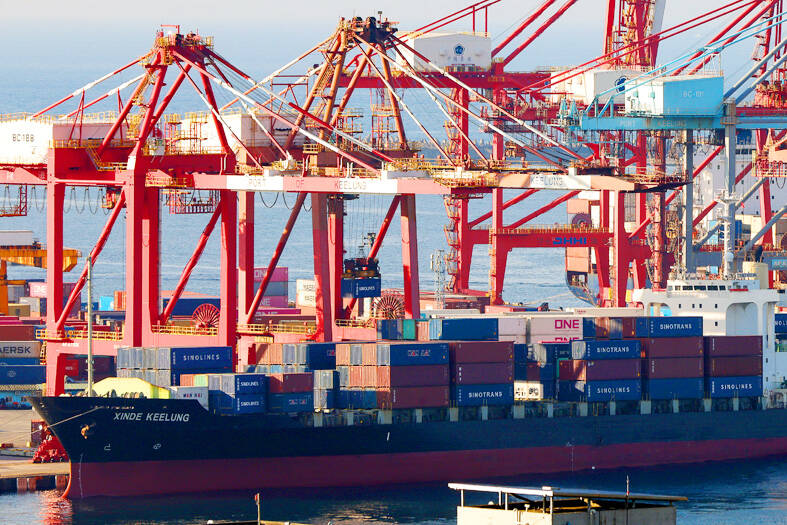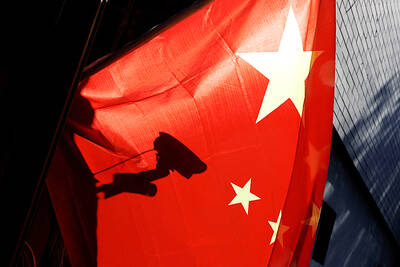The Directorate-General of Budget, Accounting and Statistics (DGBAS) yesterday upgraded its first-quarter GDP growth expectation for Taiwan to 5.37 percent after in February estimating 3.46 percent for the period.
The upgrade reflects stronger-than-expected exports due to demand for technology goods, and solid capital formation on the part of the government, public enterprises and private firms, the agency said in a statement.
“Due to the strong demand for electronic, and information and communications products, real exports of goods and services grew by 20.11 percent year-on-year” in the first quarter, the statement said, adding that “imports also grew by 23.66 percent year-on-year.”

Photo: Ritchie B. Tongo, EPA-EFE
“Regarding gross capital formation, investments in machinery equipment, construction and intellectual property products increased,” it said.
Combining inventory changes, real gross capital formation expanded 14.72 percent year-on-year, it said.
The 5.37 percent GDP growth in the January-to-March quarter accelerated from 2.90 percent in the previous quarter and marked the strongest expansion since the first quarter last year, when it was 6.64 percent, DGBAS data showed.
The agency’s preliminary GDP data, which are to be revised after more data are collected in the coming weeks, exceeded Yuanta Securities Investment Consulting Co’s (元大投顧) forecast of 4.2 percent.
“Exports of artificial intelligence-related goods are booming and uncertainty over US tariffs has led manufacturers to front-load goods in advance, while firms continue to invest in advanced semiconductor process technologies and a stable labor market supports domestic consumption,” Yuanta said of its prediction in a note ahead of the DGBAS statement.
In February, the DGBAS forecast Taiwan’s full-year economic growth would be 3.14 percent.
However, several research institutes in the past few weeks revised their predictions to below 3 percent, citing US tariff concerns and shifting dynamics in global trade.
US President Donald Trump on April 2 imposed a 32 percent “reciprocal” tariff on Taiwan, but on April 9 paused it for 90 days, although a 10 percent baseline tariff remains in place.
The initial tariffs would still have a substantial effect on growth, given Taiwan is a trade-reliant economy and the US accounted for 23.4 percent of Taiwan’s overall exports last year.
The Chung-Hua Institution for Economic Research (中華經濟研究院) last month cut its full-year GDP growth forecast to 0.16 percent in the worst-case scenario.
Last week, the IMF forecast that Taiwan’s economy would grow 2.9 percent, while S&P Global predicted 2.1 percent GDP growth this year.
If growth rates in the final three quarters follow the DGBAS’ forecasts, this year’s GDP growth would be 3.6 percent, the agency said yesterday, although the projection did not take into account the effects of US tariffs.
The agency is scheduled to update its full-year GDP growth data at the end of this month.

A magnitude 7.0 earthquake struck off Yilan at 11:05pm yesterday, the Central Weather Administration (CWA) said. The epicenter was located at sea, about 32.3km east of Yilan County Hall, at a depth of 72.8km, CWA data showed There were no immediate reports of damage. The intensity of the quake, which gauges the actual effect of a seismic event, measured 4 in Yilan County area on Taiwan’s seven-tier intensity scale, the data showed. It measured 4 in other parts of eastern, northern and central Taiwan as well as Tainan, and 3 in Kaohsiung and Pingtung County, and 2 in Lienchiang and Penghu counties and 1

A car bomb killed a senior Russian general in southern Moscow yesterday morning, the latest high-profile army figure to be blown up in a blast that came just hours after Russian and Ukrainian delegates held separate talks in Miami on a plan to end the war. Kyiv has not commented on the incident, but Russian investigators said they were probing whether the blast was “linked” to “Ukrainian special forces.” The attack was similar to other assassinations of generals and pro-war figures that have either been claimed, or are widely believed to have been orchestrated, by Ukraine. Russian Lieutenant General Fanil Sarvarov, 56, head

FOREIGN INTERFERENCE: Beijing would likely intensify public opinion warfare in next year’s local elections to prevent Lai from getting re-elected, the ‘Yomiuri Shimbun’ said Internal documents from a Chinese artificial intelligence (AI) company indicated that China has been using the technology to intervene in foreign elections, including propaganda targeting Taiwan’s local elections next year and presidential elections in 2028, a Japanese newspaper reported yesterday. The Institute of National Security of Vanderbilt University obtained nearly 400 pages of documents from GoLaxy, a company with ties to the Chinese government, and found evidence that it had apparently deployed sophisticated, AI-driven propaganda campaigns in Hong Kong and Taiwan to shape public opinion, the Yomiuri Shimbun reported. GoLaxy provides insights, situation analysis and public opinion-shaping technology by conducting network surveillance

‘POLITICAL GAME’: DPP lawmakers said the motion would not meet the legislative threshold needed, and accused the KMT and the TPP of trivializing the Constitution The Legislative Yuan yesterday approved a motion to initiate impeachment proceedings against President William Lai (賴清德), saying he had undermined Taiwan’s constitutional order and democracy. The motion was approved 61-50 by lawmakers from the main opposition Chinese Nationalist Party (KMT) and the smaller Taiwan People’s Party (TPP), who together hold a legislative majority. Under the motion, a roll call vote for impeachment would be held on May 19 next year, after various hearings are held and Lai is given the chance to defend himself. The move came after Lai on Monday last week did not promulgate an amendment passed by the legislature that